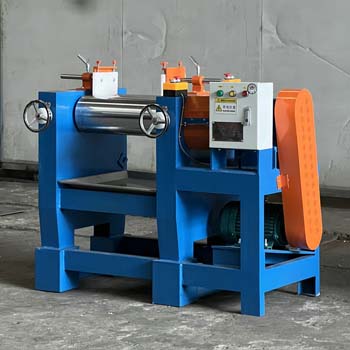The laboratory mixing mill are also known as a two-roll mill, it is one essential mixing equipment widely used in rubber ,silicone and plastic compounding material.
The two counter roller as the main component of this laboratory mixing mill machine , it plays crucial in the mixing equipment, responsible for mixing, shearing, plasticizing, and dispersing the compound material .
In this blog ,let us explore the structure of the rollers of laboratory mixing mill equipment , including the compound material, rolls surface, internal design, and their special functions in industrial and laboratory applications.
1. Basic Structure of Rollers of Lab Mixing Mill Equipment:
The rollers of Laboratory mixing mill are typically made from alloy chilled cast iron or forged steel, whose hardness can reach up to HS65 ,which is very hard , wear resistant and durable . Each roller includes several structural components:
1. Roll Body
* The roll is cylindrical shape ,it feature with a smooth, hardened surface.
* The surface hardness of this rolls are usually between HS 65-70 to withstand friction and mechanical force.
* This roll can be mirror-polished, chrome-plated, or corrugated ,which depends on your processing requirements for different material .
2. Roll Journal
* The extended shaft ends that support the roller in bearings.
* Transmits torque from the drive system to rotate the roller.
3. Roller Core (Internal Channels)
* The rolls can be internal drilled or spiral channels, specially used for heating/cooling circulation (water, oil, or steam).
* The roll core can ensure uniform temperature distribution across the roll surface ,but not focus on certain area
4. Bearing and Drive Coupling
* The roll can be installed heavy-duty bearings ,so that operate smoothly .
* The lab two roll mill is connected with a motor or gearbox ,which can control and adjust differential rotation between the front and rear rollers.
2. Special Functions of Mixing Mill Rollers
🔄 Shearing and Compounding
Since these two counter roll rotating in different speed ,which generate intense shearing force. This strong shearing breaks down agglomerates and helps to blend and homogenize the compound material evenly and uniformly for these material like rubber, TPR, PVC, Polymer ,Chemical ,pigment or color masterbatch etc.
🌡️ Precise Temperature Control
The internal channels allow precise temperature control on the roller surface , which is crucial for heating and softening materials without scorching.
This laboratory mixing mill equipment can process thermal plasticizing and avoids premature vulcanization in rubber compounds.
🌀 Friction Ratio Functionality
The two counter cyclinder roll rotate in direct at different speed . One roller typically rotates faster than the other roll so that create strong shear foce . Usually ,the friction ratio is 1:1.2 or 1:1.4 or customized design and made . You can also tailored the two roll mill and custom higher ratio,which can increase mixing efficiency and dispersive strength.
🧽 Material Film Formation
As material passes through the gap between the two rollers, it forms a thin film.The thickness of film can be adjust by way of adjusting the gap between these two rolls.
This squeeze process from these two counter roll can promote the stretch of material from layer-by-layer ,which also enhance dispersion and elasticity.
🔁 Reverse & Forward Operation
Usually ,for the modern laboratory mixing mills allow the two counter rollers to rotate in reverse, which enable forward and back mixing cycles. Thus ,these lab two roll mills are widely useful for repetitive kneading and re-compounding during lab trials in university & institute or other research center setting.
3. Types of Roller Surface for Special Functions
Generally ,the surface type of roll can be separated in several kinds . Different surface type of roll have special features for different material application . Here are example as follows:
* Smooth/Polished: The polished or smooth roll is suitable for mixing and shearing Rubber, silicone, PVC,plastics etc.
* Corrugated : The corrugated roll enhanced friction and tearing action ,it is more suitable for processing of tough rubber, reclaim mixing etc.
* Chrome-Plated: The chrome-plated rolls are anti-rust, anti-sticking, easy to clean, they are more suitable for TPE, TPR , medical materials etc.
* Mirror Finish: Many user require the rollers to be mirror finished , in order for high-precision dispersion, prevents sticking, they are mainly used for Laboratory research and R&D mills etc.
In conclusion ,the roller of laboratory mixing mill equipment is the core working component , it determine the mechanical strength, thermal control, and surface precision of two roll mill .
The internal design, surface finish, and motion dynamics of mixing rolls play crucial role in how effectively materials are blended.







